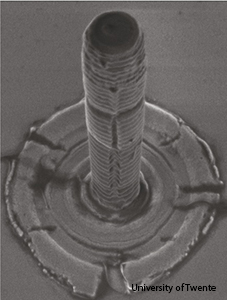
Micropillar consisting of acentral GaAs layer sandwiched between two Bragg stacks made from alternating layers of GaAs and AlAs.
Spontaneous emission is just that: spontaneous. In ordinary circumstances, a single excited atom or molecule will emit a photon at a random time. A team of Dutch and French scientists recently developed a new model for controlling the times of such emissions at the quantum level (Opt. Express 21, 23130).
Since scientists usually cannot predict exactly when single photons will be emitted, they speak of the average emission time for large numbers of excited atoms. However, for ultra-small devices, or for applications such as quantum computing and quantum cryptography, researchers would like the ability to rely on well-timed light bursts as small as a single photon.
Scientists at the University of Twente (Netherlands) and the Institute for Nanoscience and Cryogenics (France) modeled the behavior of two-level emitters confined inside a microcavity resonator. Changing the cavity resonance on a timescale faster than the average emission time bunches up the emitted photons into short, controllable bursts. For a theoretical average emission time of 1 ns, the resonance switching could cut the pulse's duration to 35 picoseconds—30 times shorter than the average emission time.
Lead author Henri Thyrrestrup Nielsen says that the group is trying to verify this effect experimentally using semiconductor quantum dots embedded in a micropillar resonator that is switched in time. The micropillar is a tall, narrow sandwich of the semiconductors gallium arsenide and aluminum arsenide. The researchers will aim an ultrashort laser pulse at the micropillar while the quantum dots are in their excited state. The team expects that the pulse will change the refractive index of the resonator and thus the effective length of the resonator.
